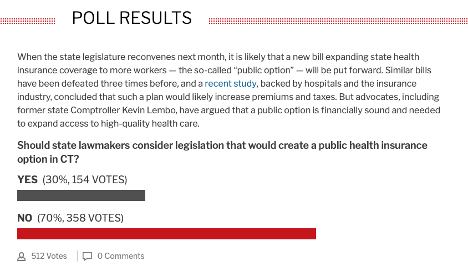ICYMI: 70 Percent Of Respondents In Online Poll Say Connecticut Lawmakers Should Not Consider Public Option Legislation
HARTFORD, Conn. – As Connecticut lawmakers prepare to convene the 2022 legislative session in early February, the Hartford Business Journal conducted an online poll of its readers to ask if the state legislature should consider legislation that would create a state government-controlled health insurance system known as the public option.
An overwhelming 70 percent of respondents said that state lawmakers should not consider this legislation. Lawmakers have tried and failed three times to create an unaffordable new state government-controlled health insurance system. Despite last year’s bill stalling amid widespread opposition and concern, including from Governor Ned Lamont, the Hartford Business Journal notes that some lawmakers are likely to make yet another push for the failed proposal in 2022.

The Hartford Business Journal reported last week on a new study by KNG Health Care Consulting which found that creating the public option in Connecticut could result in higher taxes and premiums and also reduce access to quality health care. Key findings of the report, which was supported by Connecticut’s Health Care Future, include:
State revenue from premium taxes and health insurance assessments could fall between $71 million and $122 million by 2023.
The state would likely have to increase in taxes and assessments on health insurers or through additional taxes on businesses and individuals in order make up that shortfall.
In four of six scenarios modeled, the increase in the number of uninsured ranges from 9,000 to 29,000 because of higher premiums for workers, especially for those whose employers do not take up the public option.
If the new insurance plan is as underfunded as Connecticut’s current insurance plan for non-state employees, the state would likely need to raise premiums or other tax revenues. This would result in a heavier financial burden for residents, or cut provider reimbursement rates, which could negatively affect access to high-quality treatment and services.
Read more on key takeaways from the KNG study, HERE.
To read the full KNG study, click HERE.
